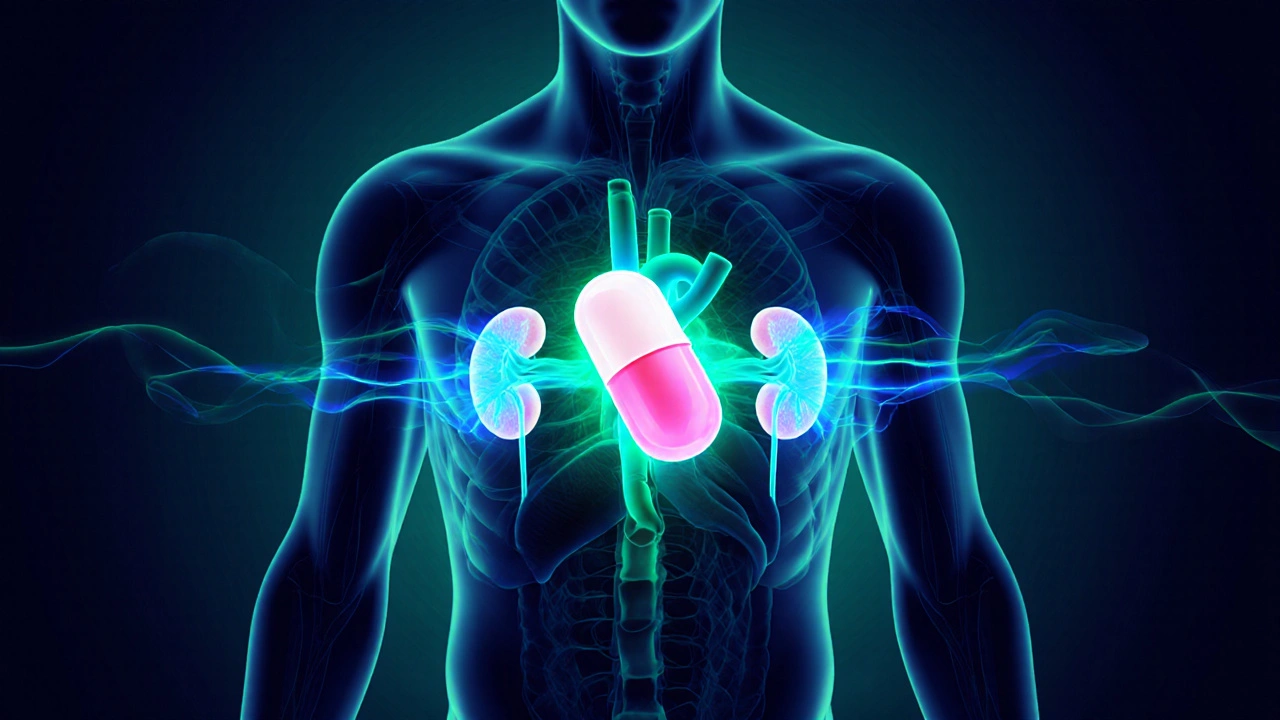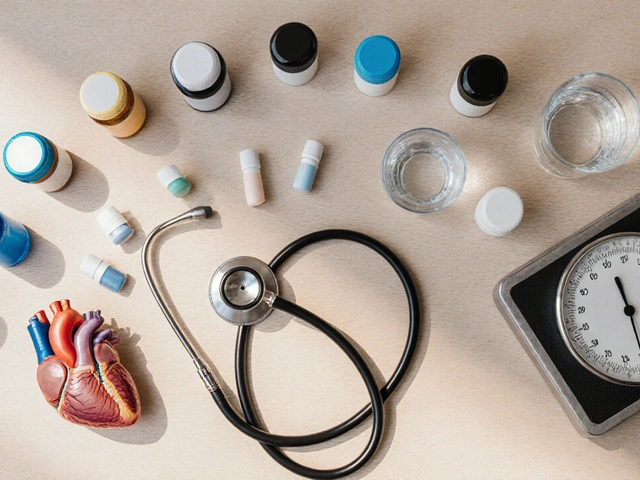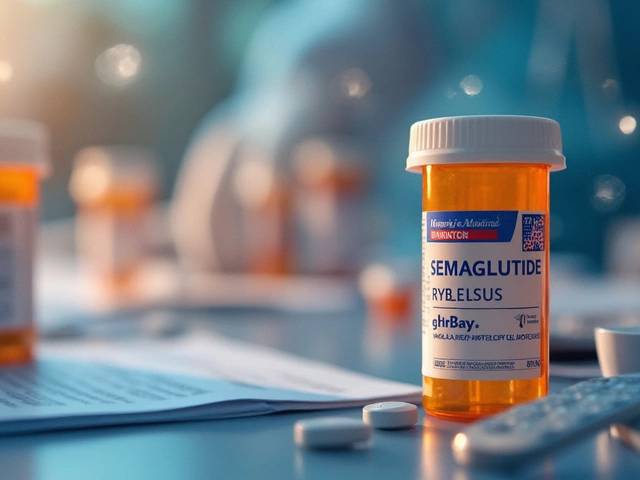Diabetes Medication Selector: Empagliflozin vs Alternatives
Your Health Profile
Your Recommendations
Enter your health details above to see personalized medication recommendations.
When it comes to managing type 2 diabetes, the market is crowded with options that promise better glucose control, weight loss, and even heart protection. Empagliflozin comparison is a frequent Google search because patients and clinicians alike want to know whether this SGLT2 inhibitor truly stands out or if another drug might fit better. Below you’ll find a no‑fluff rundown that pits Empagliflozin against its most common rivals, covering efficacy, safety, cost, and real‑world usability.
Key Takeaways
- Empagliflozin shows the strongest cardiovascular mortality reduction among SGLT2 inhibitors.
- Dapagliflozin and canagliflozin offer similar glucose‑lowering power but differ in kidney safety profiles.
- Non‑SGLT2 options like metformin remain first‑line because of cost and tolerability.
- GLP‑1 agonists (e.g., liraglutide) provide superior weight loss but require injections.
- Insurance coverage and out‑of‑pocket cost often tip the balance more than clinical differences.
What Is Empagliflozin?
Empagliflozin is a selective sodium‑glucose co‑transporter 2 (SGLT2) inhibitor approved by the U.S. FDA in 2014 for adults with type 2 diabetes. It works by blocking glucose reabsorption in the proximal renal tubules, forcing excess sugar out via urine. The result: lower HbA1c, modest weight loss, and a drop in blood pressure.
How SGLT2 Inhibitors Work
SGLT2 inhibitors are a class of oral anti‑hyperglycemic agents that target the sodium‑glucose co‑transporter 2 protein in the kidney. By inhibiting this transporter, they reduce the renal threshold for glucose, leading to glucosuria. Aside from glycemic control, large cardiovascular outcome trials have revealed class effects such as reduced heart‑failure hospitalizations.
Major Alternatives Overview
When clinicians compare Empagliflozin, they usually look at three other SGLT2 inhibitors and two non‑SGLT2 agents that sit in the same treatment algorithm.
- Dapagliflozin - Another SGLT2 inhibitor with a once‑daily 10mg dose, notable for its renal‑protective data in the DECLARE‑TIMI 58 trial.
- Canagliflozin - The first SGLT2 inhibitor on the market, offering a 300mg dose but carrying a higher risk of lower‑extremity amputation.
- Metformin - The long‑standing first‑line oral agent, cheap, well‑tolerated, but without the cardiovascular benefits of SGLT2 blockers.
- Liraglutide - A GLP‑1 receptor agonist administered subcutaneously, delivering strong HbA1c reductions and weight loss, but at a higher cost and injection burden.

Side‑by‑Side Comparison Table
| Attribute | Empagliflozin | Dapagliflozin | Canagliflozin | Metformin | Liraglutide |
|---|---|---|---|---|---|
| Drug class | SGLT2 inhibitor | SGLT2 inhibitor | SGLT2 inhibitor | Biguanide | GLP‑1 receptor agonist |
| Typical dose | 10mg once daily | 10mg once daily | 100mg daily (up to 300mg) | 500mg twice daily (up to 2000mg) | 0.6mg daily ( titrate to 1.8mg ) |
| HbA1c reduction | 0.6‑0.8% | 0.5‑0.7% | 0.6‑0.9% | 1.0‑1.5% | 1.0‑1.5% |
| Weight change | -2kg | -1.5kg | -2.5kg | Neutral | -3 to -5kg |
| Cardiovascular mortality | Reduced 38% (EMPA‑REG OUTCOME) | Neutral to modest benefit | Neutral | No proven benefit | Reduced major adverse CV events |
| Kidney protection | Slows eGFR decline | Strong renal benefit (CREDENCE) | Renal benefit but higher AKI risk | Stabilizes eGFR | Modest renal benefit |
| Common side effects | UTI, genital mycotic infection | UTI, genital infection | UTI, genital infection, amputations | GI upset, lactic acidosis (rare) | Nausea, vomiting, pancreatitis risk |
| Annual cost (US, 2025) | $5,400 | $5,200 | $5,600 | $300 | $12,000 |
Efficacy and Blood‑Sugar Control
All three SGLT2 inhibitors lower fasting glucose by roughly the same margin (0.5‑0.9%). In head‑to‑head trials, Empagliflozin edged out dapagliflozin by 0.1% in HbA1c reduction, a difference that most clinicians consider clinically negligible. Metformin, though older, still delivers the biggest drop (up to 1.5%) when used at maximal doses, which is why it remains first‑line.
If your priority is rapid, sizable HbA1c improvement without adding a GLP‑1 injection, liraglutide matches Metformin’s efficacy but at a cost that exceeds many insurance tiers. For patients already on Metformin, adding an SGLT2 inhibitor can shave another 0.5‑0.7% off the HbA1c, making combination therapy a common practice.
Cardiovascular Outcomes
The EMPA‑REG OUTCOME trial (2015) showed a 38% relative risk reduction in cardiovascular death for patients on Empagliflozin versus placebo. This remains the strongest CV signal among SGLT2 blockers. Dapagliflozin’s DECLARE‑TIMI 58 trial demonstrated a 17% reduction in cardiovascular death or hospitalization for heart failure, but the mortality component alone was not significant. Canagliflozin’s CANVAS program reported a 14% MACE reduction, though its renal benefits were more pronounced than its heart‑death impact.
GLP‑1 agonists like liraglutide have demonstrated a 13% MACE reduction in the LEADER trial, which is impressive but does not specifically target heart‑failure outcomes. Metformin’s CV advantage is modest and largely observational.
Kidney Protection and Safety
Kidney disease is a leading complication of diabetes. Empagliflozin slows eGFR decline by about 0.3mL/min/1.73m² per year. Dapagliflozin earned FDA approval for chronic kidney disease (CKD) progression reduction in 2023, showing a 39% relative risk reduction. Canagliflozin also got a CKD indication, but clinicians monitor it closely for rare cases of acute kidney injury and amputation risk.
Metformin is safe in mild‑to‑moderate CKD (eGFR≥30) but must be dose‑adjusted. GLP‑1 agents have a neutral renal effect, making them a secondary choice when kidney protection is a priority.
Weight Management
Weight loss is a welcomed side effect of SGLT2 inhibitors. Empagliflozin typically yields a 2kg reduction after 6 months; canagliflozin can reach 2.5kg, while dapagliflozin averages 1.5kg. Liraglutide outperforms them all, dropping 3‑5kg, which can be decisive for obese patients.
Metformin’s weight impact is neutral to modestly negative. If an overweight patient refuses injections, Empagliflozin offers a sweet spot of modest loss with oral administration.

Side‑Effect Profile
All SGLT2 inhibitors share a propensity for genital mycotic infections (5‑10% incidence) and urinary tract infections (UTIs). Empagliflozin’s rates sit in the middle of the class. Unique to canagliflozin is the increased risk of lower‑extremity amputation (approximately 0.2% excess), prompting FDA warnings in 2017.
Dapagliflozin has the lowest reported amputation risk, making it preferable for patients with peripheral artery disease. Metformin’s most common adverse events are gastrointestinal (nausea, diarrhea) that usually settle after a few weeks.
Liraglutide’s chief complaint is nausea, often mitigated by gradual titration. Rarely, pancreatitis can develop, so clinicians screen for pancreatic disease beforehand.
Cost and Insurance Landscape in 2025
Drug pricing continues to be a roadblock. As of 2025, the average wholesale price (AWP) per patient year is:
- Empagliflozin: $5,400
- Dapagliflozin: $5,200
- Canagliflozin: $5,600
- Metformin: $300 (generic)
- Liraglutide: $12,000 (brand‑only)
Most private insurers have Tier2 formularies for SGLT2 inhibitors, requiring a prior authorization that includes an indication of cardiovascular or renal disease. Medicare PartD typically places these drugs in the specialty tier, leading to higher out‑of‑pocket costs unless a patient qualifies for the Low‑Income Subsidy.
When cost is the dominant factor, many clinicians start with metformin, add a low‑cost sulfonylurea if needed, and reserve SGLT2 inhibitors for patients with established heart‑failure or CKD. For patients with robust insurance coverage, the decision shifts toward clinical benefit rather than price.
Who Should Choose Empagliflozin?
Empagliflozin shines in three scenarios:
- Patients with type 2 diabetes and established atherosclerotic cardiovascular disease (ASCVD) who need proven mortality reduction.
- Those with mild‑to‑moderate CKD (eGFR≥30) who also want an oral option that slows kidney progression.
- Individuals who prefer an oral medication over injectable GLP‑1 agents but still desire modest weight loss.
It’s less ideal for:
- Patients with recurrent genital infections or frequent UTIs.
- Those with severe peripheral artery disease where any amputation risk, however small, is unacceptable.
- Patients on a tight budget without robust insurance support.
Practical Prescribing Tips (Pro Tips)
- Start empagliflozin at 10mg once daily; consider 25mg if eGFR≥45mL/min/1.73m² and HbA1c remains >7.5% after 3months.
- Pair with metformin unless contraindicated; the combination yields additive glucose‑lowering effects without overlapping side effects.
- Educate patients about “sweet urine” - it’s normal and a sign the drug works. Reinforce hydration to mitigate UTI risk.
- Monitor renal function at baseline, 4‑weeks, and then every 3‑6months. Discontinue if eGFR falls below 30mL/min/1.73m².
- For patients on loop diuretics, check electrolytes for possible hyperkalemia, especially if they have heart failure.
Frequently Asked Questions
Can I take Empagliflozin if I have a history of urinary tract infections?
Empagliflozin increases glucose in the urine, which can predispose to UTIs. If you’ve had multiple infections in the past year, your doctor may choose a different class or prescribe prophylactic measures such as increased fluid intake and early treatment of symptoms.
How does Empagliflozin compare to Dapagliflozin for kidney disease?
Both drugs slow eGFR decline, but dapagliflozin has a dedicated CKD indication based on the DAPA‑CKD trial, showing a 39% relative risk reduction. Empagliflozin’s renal benefit is solid, yet the evidence is slightly less extensive for isolated CKD without diabetes.
Is the cardiovascular benefit of Empagliflozin independent of blood‑sugar control?
Yes. The EMPA‑REG OUTCOME analysis showed mortality reduction even after adjusting for HbA1c changes, suggesting mechanisms beyond glucose lowering, such as reduced oxidative stress and improved cardiac metabolism.
What should I do if I develop a genital yeast infection while on Empagliflozin?
Promptly treat with over‑the‑counter antifungal cream (e.g., clotrimazole). If infections recur more than twice a year, discuss alternative therapy with your clinician, as persistent infections may outweigh the drug’s benefits.
Can Empagliflozin be used in type 1 diabetes?
It is not FDA‑approved for type 1 diabetes due to the risk of diabetic ketoacidosis (DKA). Some specialists prescribe it off‑label with strict monitoring, but the standard of care remains insulin‑based therapy.









Comments (14)
Akinde Tope Henry
October 13, 2025 AT 14:59 PMEmpagliflozin delivers solid CV benefit, but the price is steep for many Nigerians.
Dean Marrinan
October 13, 2025 AT 16:07 PMWow, a deep‑dive into SGLT2s! 🌟 If you love comparing pills like they’re Pokémon, you’re in the right spot. Empagliflozin struts in with a 38% cut in CV death-talk about a show‑stopper, while dapagliflozin just waves a “meh” at the crowd. 💅 Meanwhile, canagliflozin brings the drama of amputations-nothing says ‘I’m edgy’ like a foot‑loss risk. And let’s not forget metformin, the humble backyard hero that’s still cheaper than a cup of coffee. 🍵 Bottom line: pick your poison based on wallet, heart, and how much you enjoy reading tables.
Oluseyi Anani
October 13, 2025 AT 17:16 PMHey there, let me break it down for you. Empagliflozin’s CV mortality reduction is statistically solid, not just a hype bump. Its modest weight loss of about 2 kg is consistent across trials, so you can trust the data. If you’re worried about UTIs, remember they’re class‑wide, not unique to Empagliflozin. Finally, consider kidney function: the drug slows eGFR decline, but dapagliflozin still has the edge in pure CKD outcomes.
Rahul yadav
October 13, 2025 AT 18:24 PMReading through this feels like watching a well‑choreographed dance of data and hope. 🌈 Empagliflozin twirls onto the stage, offering heart‑saving moves while gently shedding a couple of kilos. The rhythm of its renal protection is subtle yet reassuring, especially for those battling CKD. For anyone who fears needles, this oral hero makes the journey feel less daunting-just a little pill, a lot of possibilities. 🙏
Dan McHugh
October 13, 2025 AT 19:32 PMGood data, but price matters.
Sam Moss
October 13, 2025 AT 20:41 PMI love how the table lays everything out-clear, colorful, and honest. Empagliflozin shines for heart health, yet metformin still wins the cost‑war. If you’re juggling weight, the SGLT2s give you that extra nudge without injections. Bottom line: match the drug to your personal health story.
Suzy Stewart
October 13, 2025 AT 21:49 PMExcellent overview! 👍 Empagliflozin’s cardiovascular benefits are truly impressive, and the grammar in this post is spot‑on. Keep an eye on those UTIs, but don’t let them distract from the overall win. 🌟
Traven West
October 13, 2025 AT 22:57 PMMinor nitpick: the phrase "strong renal benefit" appears multiple times; consider varying the wording to avoid repetition. Also, "annual cost" should be hyphenated as "annual‑cost" for clarity.
Jonny Arruda
October 14, 2025 AT 00:06 AMNice summary, especially the bullet points-they’re easy to skim.
Melissa Young
October 14, 2025 AT 01:14 AMHonestly, this whole SGLT2 hype is just pharma‑driven jargon trying to replace cheap metformin with premium price tags. If you’re not a shareholder, skip the flash.
Jami Johnson
October 14, 2025 AT 02:22 AMThe cardiovascular advantage of Empagliflozin cannot be dismissed as a statistical fluke.
Decades of epidemiologic research have taught us that mortality reductions of the magnitude seen in EMPA‑REG demand mechanistic scrutiny.
Empagliflozin’s impact on myocardial fuel utilization, oxidative stress, and arterial stiffness offers a plausible biological substrate.
Moreover, the drug’s modest natriuretic effect contributes to blood pressure lowering, which indirectly benefits the failing heart.
Yet we must remember that these benefits coexist with a class‑wide propensity for genital mycotic infections.
Patients with a history of recurrent UTIs may find the trade‑off unacceptable.
The renal data, while encouraging, still lag behind dapagliflozin’s robust CREDENCE outcomes.
In chronic kidney disease without overt diabetes, dapagliflozin’s 39 % risk reduction stands as the current gold standard.
Cost, unsurprisingly, remains the elephant in the room; at over five thousand dollars annually, Empagliflozin challenges the budget of many health systems.
For insured patients with generous formularies, the net clinical benefit may outweigh the expense.
Conversely, in under‑insured populations, metformin-though less glamorous-continues to deliver the greatest glycemic drop for the least money.
The decision matrix should therefore integrate cardiovascular history, renal function, weight goals, and socioeconomic status.
When a patient presents with both ASCVD and stage 3 CKD, Empagliflozin emerges as a rational, evidence‑based choice.
If the same patient also struggles with obesity, the modest 2 kg loss of Empagliflozin may be a secondary perk.
However, for a lean individual without heart disease, the drug’s marginal glycemic benefit does not justify its price tag.
In summary, Empagliflozin shines brightest at the intersection of heart protection and renal preservation, provided the healthcare ecosystem can absorb its cost.
Kasey Krug
October 14, 2025 AT 03:31 AMThe analysis is thorough, but a few grammar tweaks would improve readability. For instance, replace "both ASCVD and stage 3 CKD" with "both ASCVD and stage‑3 CKD" for consistency. Also, avoid repeating "Empagliflozin" in consecutive sentences; a pronoun works better.
jake cole
October 14, 2025 AT 04:39 AMHonestly, this whole piece is a glorified sales pitch. If you want real data, read the primary studies instead of this fluff.
Natalie Goldswain
October 14, 2025 AT 05:47 AMi think the post was helpful but a bit to long.
thanks for the info.